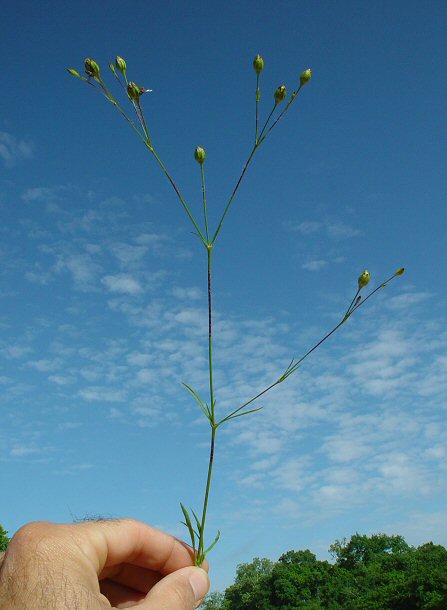Silene antirrhina L.
Sleepy Catchfly

Native
CC = 2
CW = 5
MOC = 66
© DETenaglia
Silene antirrhina L.Sleepy Catchfly | |
 |
Native CC = 2 CW = 5 MOC = 66 |
© DETenaglia |
|
Family - Caryophyllaceae Habit - Taprooted annual forb. Stems - Erect, to 80 cm, unbranched or branched, glabrous or more commonly with dense, short, soft, downward-angled hairs toward the base, often with reddish brown to purplish black, sticky bands encircling the upper internodes.
Leaves - Opposite, simple. Basal leaves usually present at flowering, usually shorter than the largest stem leaves, short-to long-petiolate. Stem leaves in mostly 6-15 pairs, sessile. Leaf blades 1-5 cm long, not succulent, oblanceolate to spatulate (basal leaves) or oblanceolate to linear (stem leaves), tapered at the base, angled to a bluntly or sharply pointed tip, the surfaces glabrous or minutely hairy, not glaucous.
Inflorescence - Open terminal panicles or dichasic cymes, rarely solitary, the stalks 10-25 cm long, glabrous, the bracts paired, glabrous, and resembling small leaves, some of the bracts with thin, white margins and a small, papery, often reddish-tinged tip.
Flowers - Perfect. Sepals 5-9 mm long, the tube with 10 parallel nonanastomosing nerves, ovoid to broadly ellipsoid, the nerves green, pale between the nerves, glabrous, the lobes triangular, often reddish purple, sharply pointed at the tip, the margins thin and white or purplish-tinged. Petals 5 or rarely absent, 8-9 mm long, the expanded portion 2-3 mm long, 2-lobed at the tip, mostly white, occasionally tinged with pink or red, rarely entirely red, with a pair of minute appendages on the upper surface at the base of the expanded portion. Stamens 10, included. Ovary green, cylindric, glabrous, superior, 3.1 mm long, 1 mm in diameter, 3-locular. Placentation axile. Styles 3.
Fruits - Capsules 5-7 mm long, dehiscing apically by 6 teeth, with a basal stalklike portion 0.5-1.0 mm long. Seeds 0.5-0.8 mm wide, kidney-shaped, the surface with minute papillae, grayish black.
Flowering - April - September. Habitat - Glades, prairies, upland forest openings, bluffs, pond margins, pastures, ditches, levees, fields, railroads, roadsides, and open, disturbed areas. Origin - Native to the U.S. Other info. - This interesting little species can be found throughout most of Missouri, though it is inconspicuous and frequently overlooked. A prime identification character is the dark, sticky bands that appear on the stems, although these are not always present. The petals are rarely seen and may be absent altogether. The plant is highly variable, and Steyermark previously recognized four forms. However, due to extensive intergradation, these divisions are not commonly used. Photographs taken in Brown Summit, NC., 6-10-02, and at Logan Creek, Reynolds County, MO., 5-23-03 (DETenaglia); also near Labadie, Franklin County, MO, 5-19-2020, and at the Blue River fishing and hunting reserve, Johnston County, OK, 5-25-2023 (SRTurner); also at Riverlands Migratory Bird Sanctuary, St. Charles County, MO, 8-1-2023 (KBildner). |